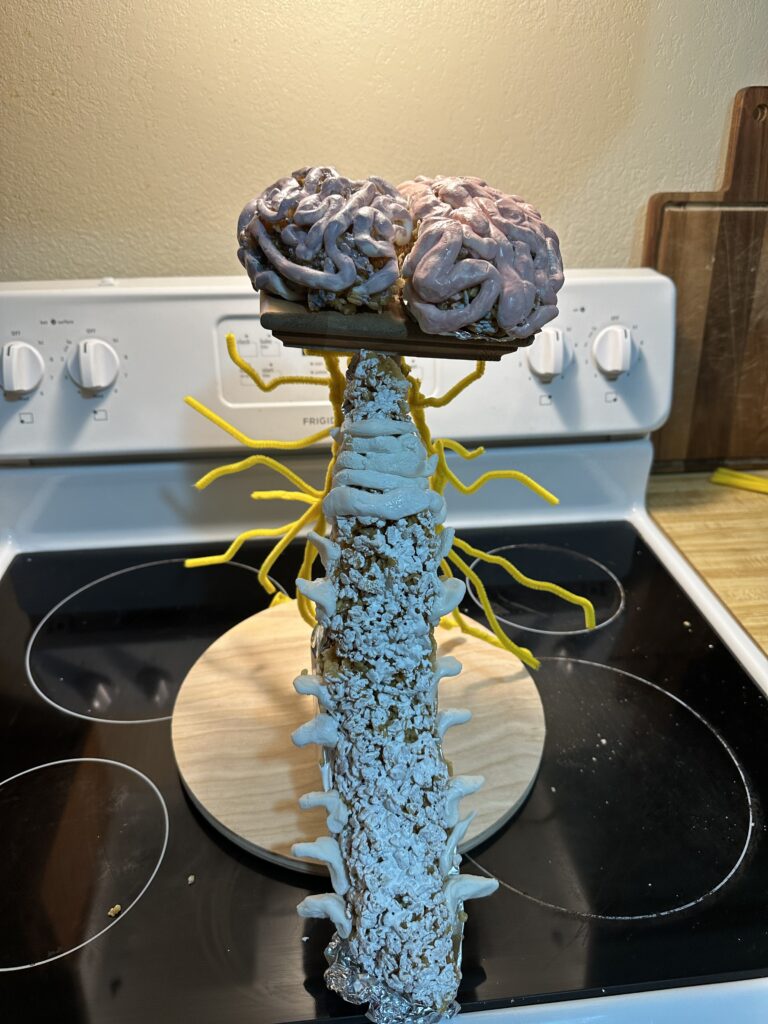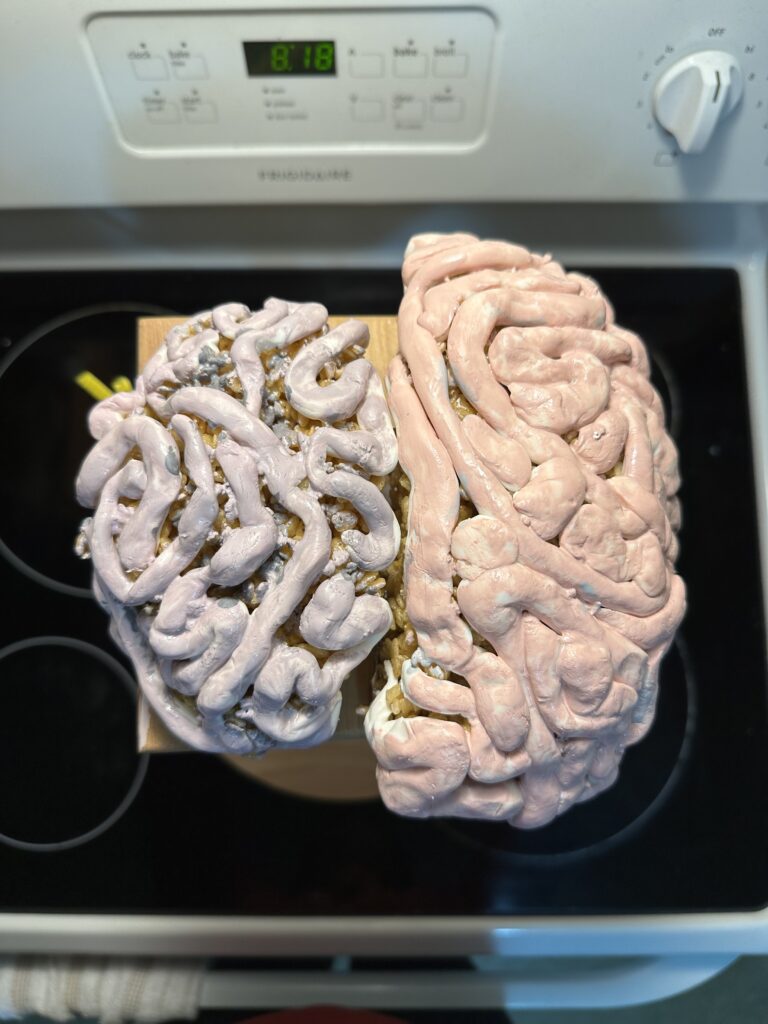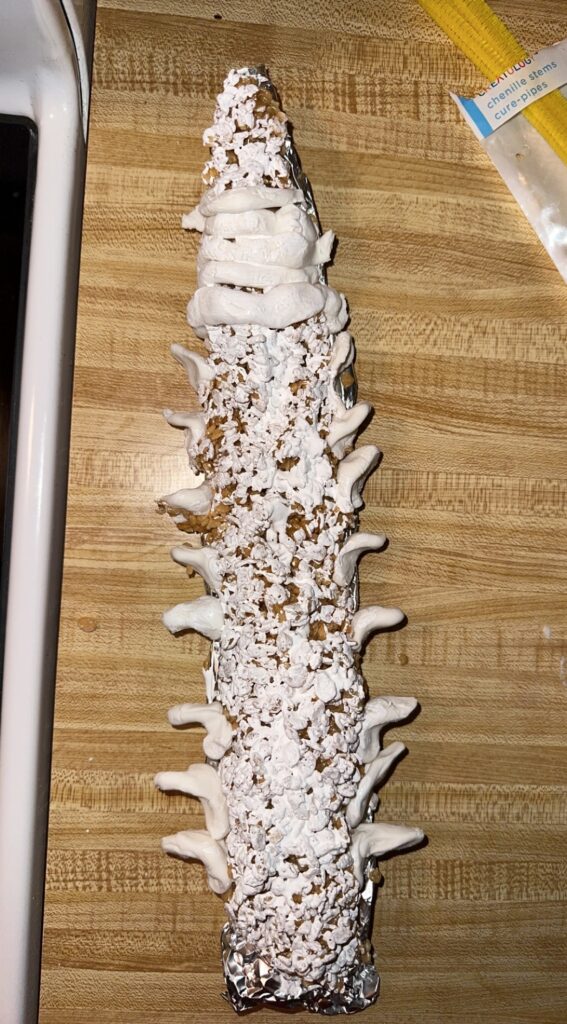


Alzheimer’s disease (AD) is a progressive neurologic disorder that causes the brain to atrophy and cells to decay. This disorder is identified from cognitive impairment accompanied by the formation of senile plaques and neurofibrillary tangles in the brain. I was able to represent AD in my project by having a side-by-side comparison of a healthy brain compared to a brain with advanced Alzheimers. You may have observed some discoloration and a noticeable amount of atrophy in the cerebral cortex in the AD brain, there are larger gaps between the folds of the gyrus compared to a healthy brain due to shrinkage. It’s not known what causes AD, but studies have shown that the neurofibrillary tangles are caused by the amyloid precursor protein (APP) turning into a different protein called beta-amyloid which doesn’t get cleared away like APP. Amyloid precusor protein is a protein that plays an important role in neural growth and repair, it acts as waste and gets flushed off of cells after broken into peptides. Beta-amyloid is found built up in the AD brain causing damage and killing the existing neurons. Beta-amyloid interacts with abnormal tau causing tangles inside neurons that block the neuron’s connections and causes a build up of senile plaques and ultimately kills the tissue. Tau is the protein that helps stabilize the microtubules in neurons, the more abnormal tau is present the more progressive the disease is. Something interesting about AD is that all of the built up beta amyloid usually happens in the early stages of Alzheimers but as time goes on the tau is actually what spreads and accumulates through the brain by oligomer “seeds” that travel across the synapse, spreading the disease and progressing its severity. Due to the damage of the cerebral cortex some common symptoms that people suffering from this disorder experience are memory loss, wandering or getting lost, misplacing things in odd places, challenges in problem-solving skills, and poor decision-making skills. As the disease worsens, the symptoms and signs of aggression and mood swings also progress along with it.
I had structured the central nervous system using rice crispy treats and colored fondant to form the shape of the brain and the spine that protects the spinal cord. One half was representing a healthy brain with normal shaped cerebral cortex and tight gyros to show healthy tissue, and the other half represents a brain with AD showing the shrinkage of the overall brain tissue and more specifically the loosely folded fondant showing the loose skinny gyros of the cerebral cortex. You may also have noticed the color difference between the two halves, a brain with AD has a lot of blockage and damage causing the brain to be discolored while the healthy brain has healthy tissue showing its pinkish-grey hue. To involve all of the key components of the nervous system I incorporated yellow pipe cleaners to show the peripheral nervous system in my structure. The peripheral nervous system (PNS) is all the nerves throughout your body that are not in your brain or spinal cord, these nerves reach to all of your limbs and torso to deliver action potentials and facilitate movement. I had formed these pipe cleaners to start at each vertebrae and spread outwards.
A. Armstrong, R. (2013). Review article what causes alzheimer’s disease? Folia Neuropathologica, 3, 169–188. https://doi.org/10.5114/fn.2013.37702
Kolarova, M., García-Sierra, F., Bartos, A., Ricny, J., & Ripova, D. (2012, May 29). Structure and pathology of tau protein in alzheimer disease. International Journal of Alzheimer’s Disease. Retrieved November 21, 2022, from https://www.hindawi.com/journals/ijad/2012/731526/
Bayer, T. A., Wirths, O., Majtényi, K., Hartmann, T., Multhaup, G., Beyreuther, K., & Czech, C. (2006). Key factors in alzheimer’s disease: β-amyloid precursor protein processing, metabolism and intraneuronal transport. Brain Pathology, 11(1), 1–11. https://doi.org/10.1111/j.1750-3639.2001.tb00376.x
Tau protein and alzheimer’s disease: What’s the connection? Tau Protein and Alzheimer’s Disease: What’s the Connection? | BrightFocus Foundation. (n.d.). Retrieved November 23, 2022, from https://www.brightfocus.org/alzheimers/article/tau-protein-and-alzheimers-disease-whats-connection
DeTure, M. A., & Dickson, D. W. (2019, August 2). The neuropathological diagnosis of alzheimer’s disease – molecular neurodegeneration. BioMed Central. Retrieved November 23, 2022, from https://molecularneurodegeneration.biomedcentral.com/articles/10.1186/s13024-019-0333-5
